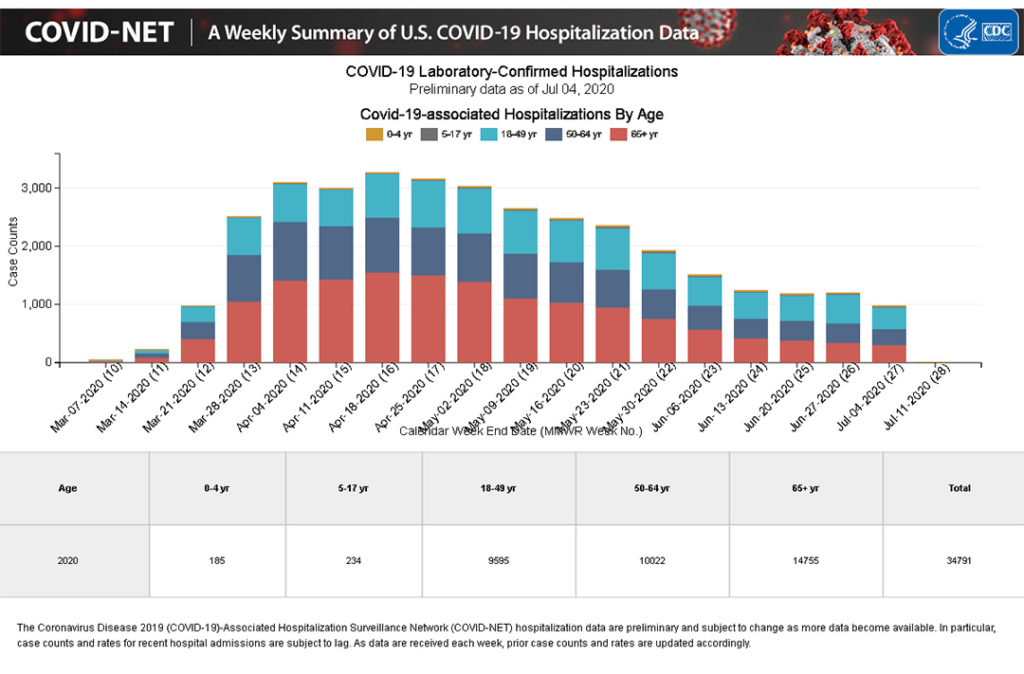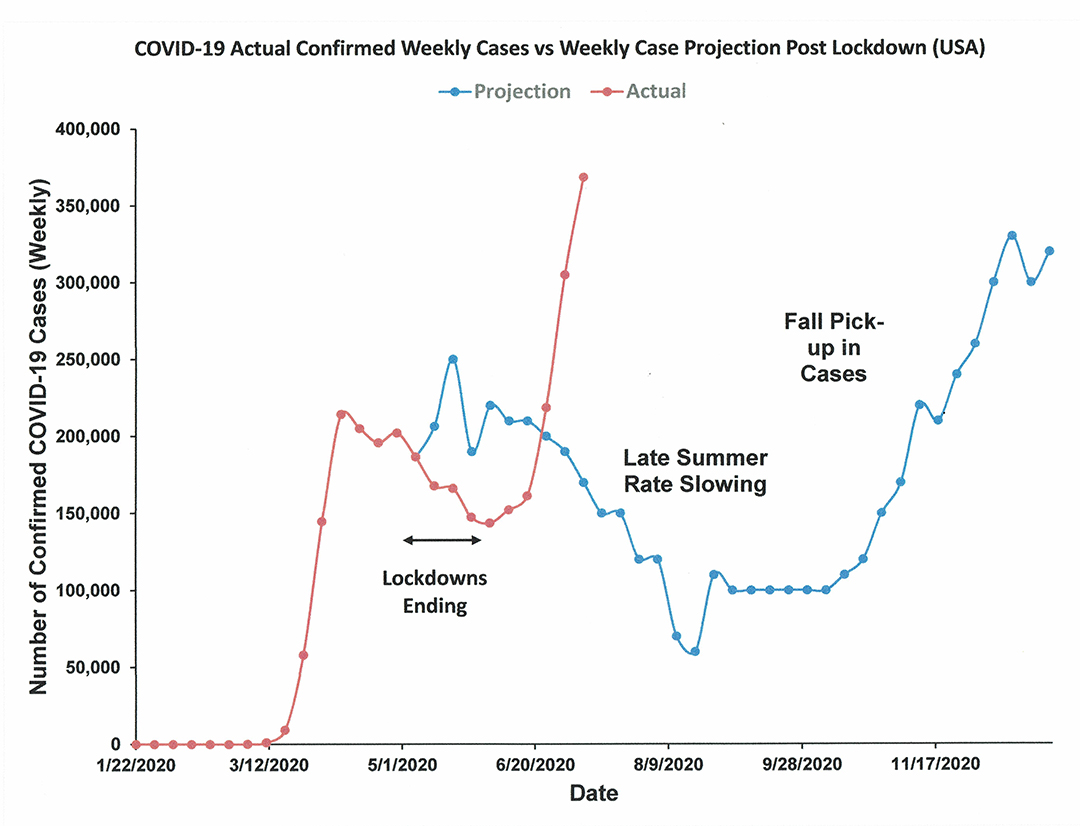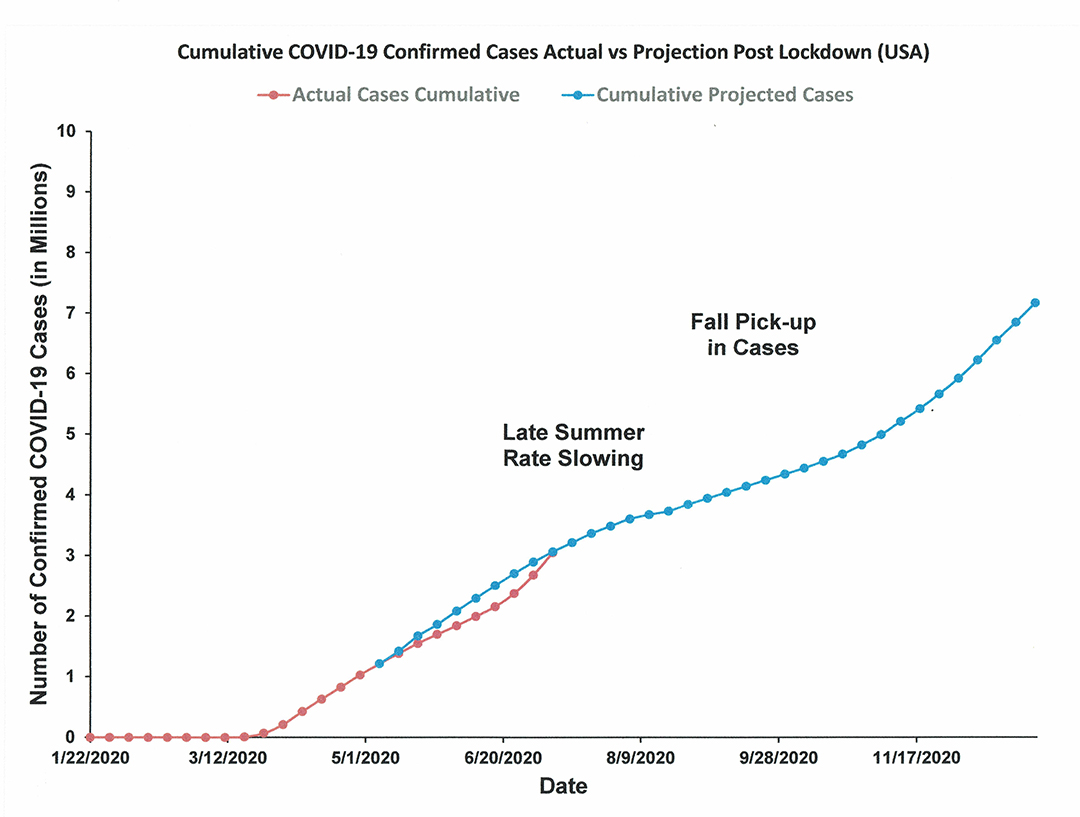Here’s another fascinating article by my friend and colleague, Dr. Marissa Carter. I believe she is an unbiased voice in the cacophony of experts, and provides insights unavailable elsewhere. I appreciate her taking the time to write these articles and share them. Find out more about her work at https://www.strategic-solutions-inc.com/
—Caroline
In 1991 in the eastern Atlantic, several factors synergized to seal the fate of the Andrea Gail and its crew, memorialized by the best-selling book and movie, “The Perfect Storm,” several years later. We are starting to face a similar situation in the US with regard to COVID-19 infection.
COVID-19 Infection and Hospitalization Rates Soar
Let’s start by looking at the actual weekly confirmed cases of COVID-19 and the cumulative total (Figures 1 and 2; source data: CDC):
Exit from lockdown in most states started at the beginning of May and with a few exceptions finished by the end of the month. The result is an exponential increase in cases that eerily parallels what happened from March 18 through April 8 as the pandemic gripped the country (Figure 1). You can also see there was delay of 2-3 weeks before cases started skyrocketing, mainly in the South. However, the age group that contracted the virus has shifted dramatically. Whereas the mean age in the first peak was around 55 years, it is now trending down toward 40 years. Although hospitals are starting to become overwhelmed in a number of cities in the South, especially Houston — and we won’t know the effect on mortality rates for several weeks — what I find interesting is that the proportion of deaths attributable to the virus in older groups (65 years and older) has steadily decreased in relation to younger groups (Figure 3; source: CDC):

The data tell us then that in the last 4-5 weeks younger people are being infected, and they are becoming hospitalized in increasing numbers compared to older people. It turns out I was far too optimistic in the long run in regard to projections because I miscalculated the behavior of the population. I don’t feel bad because many other modelers got it wrong also.
So, why are things not going so well after emerging from lockdown?
The Consequences of Lockdown
We all suffered during lockdown. However, lockdown is a rich man’s concept. It assumes that all people can bear the brunt equally, but as data have shown, the poor and disadvantaged suffered proportionally more, not just in this country, but many others. For lockdowns to be effective in curbing the spread of the virus (so that a longer-lasting level of control can be achieved), they have to be done early and hard. That did not happen in the US. To be fair, many countries decided against lockdown and did rather well as I have discussed in a previous article. While the pent-up anger and frustration over the lockdown and the joy of “being free again” has impacted behavior, especially in the young, there are many reasons why the current spread of the virus seems to have been little impacted by the lockdown:
- Some 40% of the population or more won’t wear masks or socially distance; they either don’t care, find masks too annoying, or believe their civil liberties transcend public health orders.
- Many people see the COVID-19 pandemic as “overblown” by the media; I myself have also seen examples of that.
- Many people have to work in order to survive; for many, working is a life or death issue, so they feel they have no choice but to ignore “stay at home” orders.
- Many people, especially the young, just want life to be normal so they carry on with the social activities that make epidemiologists apoplectic.
- Scientific and governmental recommendations have seesawed all over the place and political forces are pulling in opposite directions making it nearly impossible to implement coherent national policies. Additionally, the entire governmental structure of the United States is predicated on the idea that individual states have broad decision-making powers. This is what a federal system means.
- The WHO lost credibility.
CORONA Catch-22
In the 1970s novel, Catch-22, by Joseph Heller, the main character feigns madness in order to avoid dangerous combat missions, but his desire to avoid danger proves that he is actually sane. A “Catch-22” situation is one from which there is no escape because of mutually conflicting conditions. The “COVID Catch-22” is that if we want the economy to survive in order to prevent massive destruction and deaths from economic collapse, we have to work. However, if we return to work just as we did in pre-virus days, our chances of infection and death from illness increase significantly. The imposition of masks, social distancing and lack of congregation mean we cannot work efficiently, and many businesses cannot operate at all and will go bankrupt.
There is a growing sense that no matter what we do, we cannot stop this virus until we achieve herd immunity (meaning, until a lot of people have been infected and hopefully, recovered). That belief is probably starting to drive some of our behavior.
We Are Not Alone
Countries that have gotten past the worst already (and which do not have our challenges or our transparency) are pointing fingers at our management of the COVID-19 situation, despite the fact that there are recurrent outbreaks in all countries. European countries have banished us from visiting them (which is in fact, what we did to them when the infection situation was reversed). The U.S. is not the only large country that is struggling. Currently India, Brazil, and Russia are in trouble and the Middle East is also losing the battle in regard to containing the virus. Major factors that drive the spread of the virus are indecisive leadership, the challenges posed by large populations of poor people, scientific illiteracy, mixed messaging regarding public health guidance, and wishful thinking that the pandemic will blow over quickly.
The Near Future Is Just One Long Wave
Earlier we talked about this pandemic being a series of distinct waves. In particular we worried about a second more lethal wave this winter that coincides with flu season. I, along with many others, thought we might catch a break for a few months later this summer which would allow us some travel freedom within the U.S. Unfortunately, given what’s transpired since April, it’s more likely that we are going to experience one, long, perfect storm, instead of distinct waves. Here’s why:
- Our behavior in regard to social distancing and mask wearing is not going to change; in fact, it will likely deteriorate (pandemic fatigue).
- The specter of economic collapse will increase pressure to keep businesses open and workers working at them no matter what the COVID-19 implications are.
- Many people will push very hard against any further lockdowns.
- It’s going to be a long hot summer, which will add to our woes, never mind the effect of any natural disasters, such as hurricanes and forest fires.
- The current predominant viral strain has the D614G mutation, which means it’s more infectious than the older strains.
- We are also recognizing that people can become infected via airborne transmission, a concept the WHO apparently doesn’t like to articulate.
- We continue to have inadequate COVID-19 testing (numbers, and accuracy) for the number of daily cases; the percentage of positive tests needs to be <1% to have successful contact tracing.
- Shortage of skilled healthcare workers at hospitals and healthcare worker fatigue.
- High numbers of collateral deaths because people are afraid to come to hospitals or because there’s nowhere for them to go.
- We don’t know yet what the 2020-2021 flu season looks like, but the issues of co-infection and their dynamics are not looking good.
The Light at the End of the Tunnel
If there is light at the end of the tunnel, it is the development of COVID-19 vaccines. In my next article, I’ll discuss the most likely candidates and the metrics of what success and failure might look like, as well as the timeline.

Dr. Fife is a world renowned wound care physician dedicated to improving patient outcomes through quality driven care. Please visit my blog at CarolineFifeMD.com and my Youtube channel at https://www.youtube.com/c/carolinefifemd/videos
The opinions, comments, and content expressed or implied in my statements are solely my own and do not necessarily reflect the position or views of Intellicure or any of the boards on which I serve.





